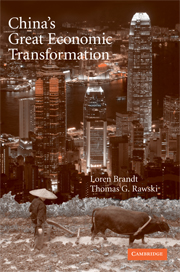Book contents
- Frontmatter
- Contents
- List of Figures
- List of Tables
- Contributors
- Acknowledgments
- Map
- 1 China's Great Economic Transformation
- 2 China and Development Economics
- 3 China in Light of the Performance of the Transition Economies
- 4 A Political Economy of China's Economic Transition
- 5 The Demographic Factor in China's Transition
- 6 The Chinese Labor Market in the Reform Era
- 7 Education in the Reform Era
- 8 Environmental Resources and Economic Growth
- 9 Science and Technology in China
- 10 The Political Economy of Private Sector Development in China
- 11 The Role of Law in China's Economic Development
- 12 China's Fiscal System: A Work in Progress
- 13 Agriculture in China's Development: Past Disappointments, Recent Successes, and Future Challenges
- 14 China's Financial System: Past, Present, and Future
- 15 China's Industrial Development
- 16 China's Embrace of Globalization
- 17 Growth and Structural Transformation in China
- 18 Income Inequality during China's Economic Transition
- 19 Spatial Dimensions of Chinese Economic Development
- 20 Forecasting China's Economic Growth to 2025
- Index
10 - The Political Economy of Private Sector Development in China
Published online by Cambridge University Press: 24 May 2010
- Frontmatter
- Contents
- List of Figures
- List of Tables
- Contributors
- Acknowledgments
- Map
- 1 China's Great Economic Transformation
- 2 China and Development Economics
- 3 China in Light of the Performance of the Transition Economies
- 4 A Political Economy of China's Economic Transition
- 5 The Demographic Factor in China's Transition
- 6 The Chinese Labor Market in the Reform Era
- 7 Education in the Reform Era
- 8 Environmental Resources and Economic Growth
- 9 Science and Technology in China
- 10 The Political Economy of Private Sector Development in China
- 11 The Role of Law in China's Economic Development
- 12 China's Fiscal System: A Work in Progress
- 13 Agriculture in China's Development: Past Disappointments, Recent Successes, and Future Challenges
- 14 China's Financial System: Past, Present, and Future
- 15 China's Industrial Development
- 16 China's Embrace of Globalization
- 17 Growth and Structural Transformation in China
- 18 Income Inequality during China's Economic Transition
- 19 Spatial Dimensions of Chinese Economic Development
- 20 Forecasting China's Economic Growth to 2025
- Index
Summary
A central theme in the current literature on the political economy of growth is the relationship between the government and the private sector. Governments that create the appropriate conditions for private risk taking foster capital accumulation, efficient allocation of resources, and sustained growth. Governments that arrogate “too much” economic activity to themselves risk low levels of investment, inefficiencies in the state sector, and defensive private strategies, such as capital flight and nonproductive investments.
There is substantial debate, however, on how to structure business-government relations in an optimal way, or even what dimensions of the relationship might be consequential (Maxfield and Schneider, 1997). One strand of the institutional economics literature emphasizes the importance of the government's role as a protector and enforcer of private property rights (Barzel, 1997, for an overview). Such protections, if credible, provide assurances to private agents that assets and income will not be expropriated and thus incentives for investment. A growing body of empirical literature attempts to document these claims. These studies show the role that property rights protection and other aspects of the institutional setting that support these protections, such as transparency or even democracy, might play in checking the predatory tendencies of the state (Keefer, 2004).
However, a very different body of theoretical and empirical literature identifies the key barrier to growth not in an overbearing state, but in the capture of public institutions by private actors and the introduction of various policy-induced distortions (e.g., Murphey, Schleifer, and Vishny, 1993).
- Type
- Chapter
- Information
- China's Great Economic Transformation , pp. 337 - 374Publisher: Cambridge University PressPrint publication year: 2008
- 37
- Cited by



